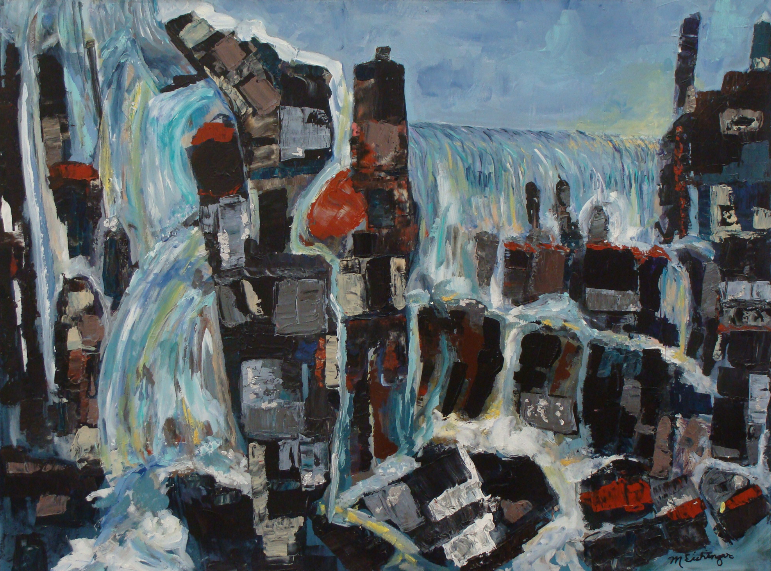
Oregon City Falls by Marilynne Eichinger
Acrylic on Canvas/ 36” x 48” / $1,100
Oregon City, the end of Oregon Trail, is the site of the first electrical cable power line in the United States. The hydro electric dam on the Willamette River produced electricity that was sent to Portland, 14 miles away. No longer a pristine power dam or site of a paper mill, this tumbling down image projects the area today. I wonder what it will look like when the earthquake strikes?
Poem by my Granddaughter, Mira Horn
Oh Grandma!
The lens through which you see this city cannot be captured through another’s brush
I wish I knew just what shape the town used to be
when waters crashed and city and sky lights touched
Here lies the first glimmer of electricity
Here lies the end of the Oregon Trail
The past upon the past, the dark against the pale
Can you tell me where the creases lie, what makes this painting blush?
Oh Grandma, I think you’ve left the city clear
Breathed in it life, and swept away the dust
(The following section is taken from soon to be published “Over The Peanut Fence.” It discusses what happens to poor and homeless people when disasters occur.
When Disaster Strikes
During times of crisis caused by natural or manmade disasters the most vulnerable among us suffer greatly. Even slight setbacks can have disastrous consequences for children, adolescents, seniors, and those with disabilities. For example, in January 2017, Portland, Oregon had an unusual storm that dumped 14 inches of snow on city streets. In general, Portland winters are mild, but that year, below-freezing temperatures plagued the city for many days.
Four homeless people died of exposure and a great many children went hungry. When schools close for inclement weather, children in low-income families are often without food. In Portland, where over 50 percent of the students participate in federally subsidized breakfast and lunch programs, cancelled school days mean lots of hungry bellies.
Though Oregon communities are involved in emergency planning, the most vulnerable are usually the last to receive services. For example,\ one recommendation for earthquake preparedness is that each person set aside 14 gallons of water in their home or apartment. Homeless people have no way of doing so.
Imagine an earthquake, hurricane, tornado or tsunami hitting your town. Responders and hospital staff will attend to the most drastic situations first. Those with bank accounts, stocked pantries, vehicles, neighbors and relatives will be better able to survive than poor or homeless people who may have to endure days, weeks or even months of added trauma.
Portland’s snowstorm last year was a wake-up call for community leaders. With limited transportation and no electricity, the Bureau of Emergency Management was incapable of giving special attention to those unable to care for their own needs. The mayor had to step in and coordinate emergency personnel to deal with the situation. Though the event lasted only a few days, it made officials recognize that they had to plan for those without shelter. Temporary housing, communication and food for the poor, the homeless, the mentally ill and homebound seniors had to be considered. Emergency planning teams concluded that a trained network of volunteers had to be part of the solution for avoiding a humanitarian crisis.
I suggest emergency preparedness be introduced in the elementary grades. Homes need to be equipped with up-to-date first-aid kits, extra food, water, and easily accessible clothing on hand. Those living together need to know how to shut off gas and electrical lines. Families (and friends) need designated meeting places to go to in case of separation. There is also a moral responsibility to help neighbors in need if you are able to do so. The process begins with surveying the neighborhood to see who might require attention, needing food, special supplies or help vacating their premise.
It is surprising how difficult it is for those in need to ask for assistance. After a heavy snow, our young wheel-chaired son often finds himself trapped indoors waiting for someone to dig out his car. Distant friends eventually come to his aid but he feels uncomfortable asking someone living in his apartment complex to help, for he doesn’t know them well. I wish someone would recognize his situation and not wait until he asks.
Children need instruction in what to do and where to go in case of an emergency. Youth who find themselves temporarily stranded will need to know how to find their parents. Those who live homeless also need to be made aware of their options. Street youth are constantly honing survival skills, but during a major disaster they will not be able to access their usual shelters or food distribution sites. Organizations like Outside In and New Avenues for Youth, the Salvation Army, etc. should consider teaching their clients what to do and where to go in a disaster.
Several weeks ago I wrote of the need for volunteer mentors to help homeless youth. Many of you responded positively to that newsletter. Emergency preparation also requires trained volunteers who know how to help for those with special needs. We all must to be prepared for natural disasters common to our part of the country but we also need to be aware that some unknown person might need our help.
